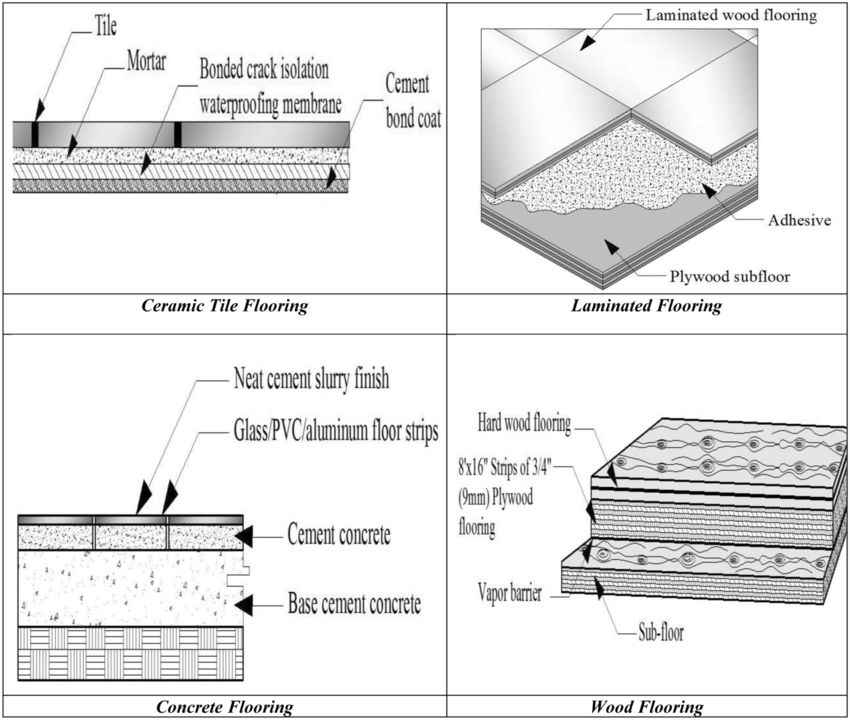Tile flooring is a popular flooring option for homes and commercial spaces due to its durability, versatility, and easy maintenance. Tiles come in a variety of materials, shapes, sizes, and colors, making it easy to find the perfect match for your design aesthetic and functional needs. From ceramic to porcelain, natural stone, and beyond, the options for tile flooring are virtually endless. When considering tile flooring, it is important to consider several key details to ensure a successful and long-lasting installation.
Materials
Tile flooring can be made from a variety of materials, each with its own unique benefits and drawbacks. Ceramic tiles are an affordable and durable option that is resistant to moisture, staining, and bacteria. They come in a wide range of colors, patterns, and textures, making them a versatile choice for any style of the room. Porcelain tiles are similar to ceramic tiles, but are even denser and more durable, making them a great choice for high-traffic areas.
Natural stone tiles, such as granite, marble, and travertine, are a popular choice for their beauty and longevity. However, they are more expensive than ceramic and porcelain tiles and are more porous, requiring regular sealing to prevent staining and damage.
Installation
When installing tile flooring, it is important to consider the type of installation method used. The most common installation methods include:
- Full spread adhesive: This method involves spreading adhesive over the entire surface area, which is then covered with tiles. This method provides a stable and long-lasting installation but is more time-consuming and messy.
- Direct bonding: This method involves applying adhesive directly to the back of the tiles, which are then applied to the floor. This method is quicker and less messy than the full-spread adhesive method, but is not as secure and may require more maintenance in the future.
- Floating: This method involves laying tiles on a floating floor system that is not attached to the subfloor. This method is quick and easy, but not as stable as the full-spread adhesive or direct bonding methods.
Maintenance
Tile flooring is generally easy to maintain, requiring regular sweeping or vacuuming and occasional mopping. Depending on the type of tile and the grout used, it may also be necessary to seal the tiles and grout to prevent staining and damage. Natural stone tiles may also require regular sealing to protect against staining and damage.
Cost
The cost of tile flooring will vary depending on the type of tile, the installation method, and the size of the space being covered. Ceramic and porcelain tiles are generally more affordable than natural stone tiles, and the floating installation method is typically less expensive than the full spread adhesive or direct bonding methods.
Tile Flooring Detail

How durable is tile flooring?
Tile flooring is generally very durable and can last for many years with proper maintenance. However, the durability of the tiles will depend on the type of tile and the installation method used.
Is tile flooring easy to clean?
Yes, tile flooring is generally easy to clean and maintain. Regular sweeping or vacuuming and occasional mopping is typically all that is needed to keep tile floors looking their best.
What are the most popular types of tile flooring?
The most popular types of tile flooring include ceramic, porcelain, and natural stone tiles.
How much does tile flooring cost?
The cost of tile flooring will vary depending on the type of tile, the installation method, and the size of the space being covered. On average, ceramic and porcelain tiles tend to be more affordable, while natural stone tiles are more expensive. The cost of installation will also impact the overall cost of the project, with floating installations being less expensive than full-spread adhesive or direct bonding methods.
Can tile flooring be installed over existing flooring?
In some cases, tile flooring can be installed over existing flooring, such as vinyl or laminate. However, it is important to ensure that the existing flooring is in good condition and is level, as any imperfections in the subfloor can cause issues with the tile installation. It is always best to consult with a professional to determine if your existing flooring is suitable for tile installation.
Are there any special considerations for tile flooring in wet areas?
When installing tile flooring in wet areas, such as bathrooms or kitchens, it is important to choose tiles that are resistant to moisture and water damage. Porcelain tiles are a popular choice for these areas due to their dense, moisture-resistant composition. Additionally, it is important to choose a suitable grout for these areas, as some grouts are more prone to cracking and staining in the presence of moisture.
Tile flooring is a versatile and durable option for both homes and commercial spaces. When considering tile flooring, it is important to consider the type of tile, the installation method, and the maintenance required to ensure a successful and long-lasting installation. With its wide range of options and benefits, tile flooring is a popular choice for those looking to upgrade their floors.
Floor-Framing Details for Tile Flooring

Floor framing, Stone tile flooring, Tile floor

Safety Surfacing Details Rubber Flooring Details Interlocking

06.130.0203 Concrete lintels, Masonry, Concrete

Floor-Framing Details for Tile Flooring

Floor Tile Installation Methods – Tile Doctor

Floor-Framing Details for Tile Flooring

Transition Between Tile and Carpet JLC Online

Floor Intersection Details Architectural Standard Drawings

Floor systems with section details Download Scientific Diagram

Ceramic Tiling – Finishes – Download Free CAD Drawings, AutoCad

stone floor detail – Google Search Concrete slab, Concrete tile

Floor Tile Installation Methods – Tile Doctor

Related articles: